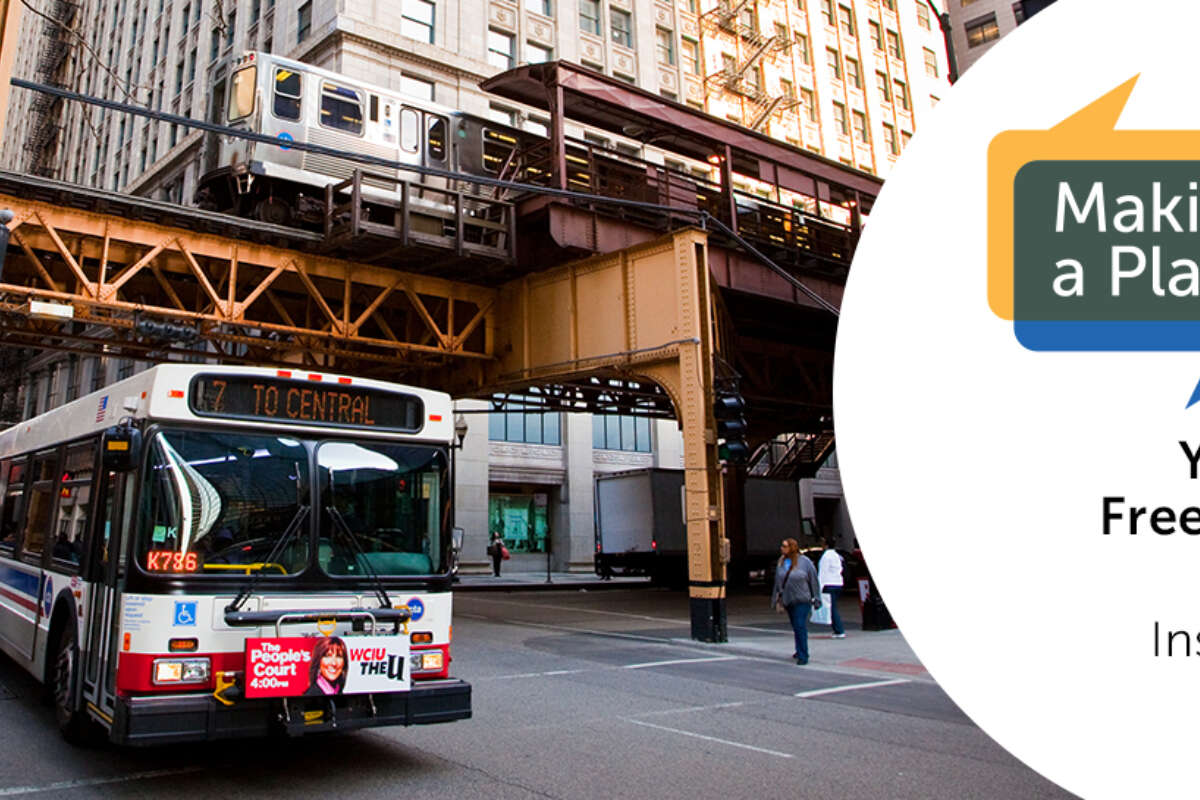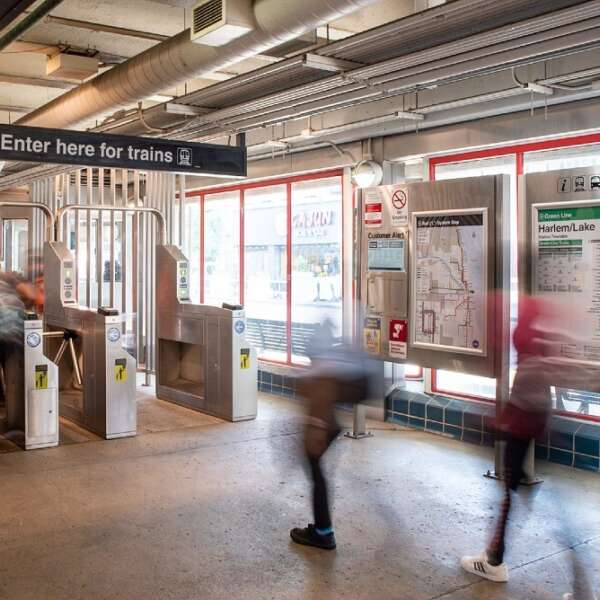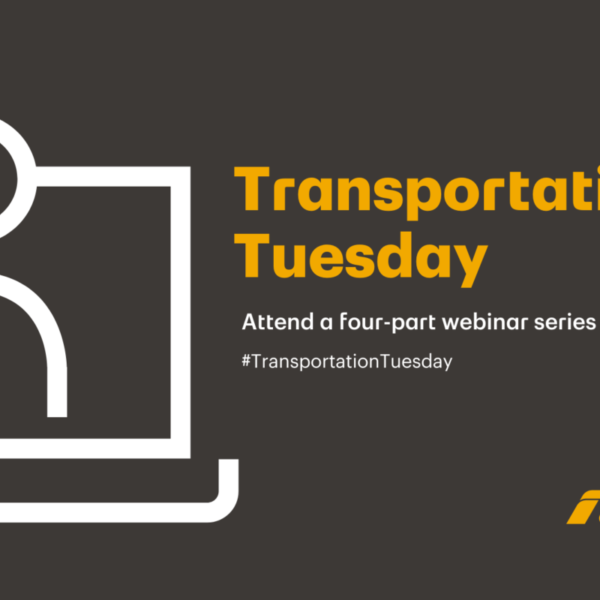Guest blogger Yonah Freemark discusses the future of the Chicago region’s transit system
September 30, 2021
September 30, 2021

T he RTA is currently developing the 2023 Regional Transit Strategic Plan for Northeastern Illinois at a time when the challenges and opportunities facing our region’s transit system have never been greater. Making a Plan represents our effort to engage and collaborate with close stakeholders and the public. We have invited a group of transit users and thinkers to answer a set of questions for an occasional guest series on Connections, the RTA blog. The views represented in this series are not those of the RTA, but they are views we want to hear and have heard. If you have thoughts about this post, the strategic plan, or would like to participate by contributing a guest blog post, please email communications@rtachicago.org and subscribe to our newsletter to learn more.
he RTA is currently developing the 2023 Regional Transit Strategic Plan for Northeastern Illinois at a time when the challenges and opportunities facing our region’s transit system have never been greater. Making a Plan represents our effort to engage and collaborate with close stakeholders and the public. We have invited a group of transit users and thinkers to answer a set of questions for an occasional guest series on Connections, the RTA blog. The views represented in this series are not those of the RTA, but they are views we want to hear and have heard. If you have thoughts about this post, the strategic plan, or would like to participate by contributing a guest blog post, please email communications@rtachicago.org and subscribe to our newsletter to learn more.
Name: Yonah Freemark
Organization or Affiliation: Urban Institute
Role/Responsibilities: Senior Research Associate
Favorite transit mode or station?
In Chicago, the Orange Line between Roosevelt and Halsted, thanks to its amazing views of the South Loop, the downtown skyline, and the Chicago River.
What do you see as the greatest challenges and opportunities for the Chicago region’s transit system over the next ten years? What is the biggest barrier to realizing these opportunities?
Chicago’s transit system will have to adjust to the realities of inequitable growth and change that characterize the region. Over the past decade, lakefront communities in the city of Chicago grew relatively quickly, especially in and around downtown. But neighborhoods further inland—and many suburban cities—lost population and lost investment. This has been a particular feature of communities where many families with low incomes and people of color live. Transit planners in the region will have to develop new service concepts that adjust to these diverging patterns, not only responding to growth, but also maintaining travel options in communities undergoing stress.
Adjusting the transit network to inequitable demographic change will require tough choices on the part of policymakers and planners. Given the limited funds available, choosing to invest in better service in one place rather than another will require careful planning, in-depth discussions with community members, and a concerted effort to redress historic underinvestment.
Tell us your ideas for improving access to transit within the Chicago region and what policy levers or partnerships might be required to make the changes you envision?
The Chicago region benefits from one of the nation’s most extensive transit networks, ensuring Chicagoland’s continued competitivity. But CTA, Metra, Pace, and the RTA can do more to improve access. The fare system discourages people with low incomes from riding Metra, and the result is inequitable access. For example, a 27-minute trip from Evanston to downtown costs $5.50 on Metra—but $2.50 for the longer, 44-minute CTA ride. The Metra trip would cost even more if it required a transfer once downtown.
Fares should be standardized across geographies, and free transfers should be provided between modes, so everyone can take the fastest option available. The South Cook low-fare pilot is a good step in this direction.
Simultaneously, CTA and Metra should coordinate with CMAP, RTA, and local governments to prioritize transit-oriented development as much as feasible. That must include maximum use of agency-owned land to promote dense, mixed-use projects rather than parking. These investments will ultimately produce more riders and more sustainable land use.
Looking ahead, what future force of change has the greatest potential to transform or disrupt our region’s transit system?
Automation has the potential to radically alter the transportation system for both the good and bad. On the one hand, automated bus and rail service could reduce the cost for CTA, Metra, and Pace to expand operations, because of the high cost of labor. In recent years, labor has accounted for more than 70 percent of CTA operating expenses, for example. With automation, frequencies could be increased and headways reduced, making transit more convenient for millions of Chicagoland residents. Automation could also result in the potential to fund more routes.
On the other hand, increasing automation could push thousands of Chicagoland workers out of their jobs. More than 900,000 workers in the Chicago region are employed in trade, transportation, and utilities. Their incomes and well-being will be affected by automation in transit, but also trucking, ride-hailing, and rail transportation. Identifying mechanisms to ensure job security and new training options is vital.
Decades of underfunding have left the transit system in a constant state of austerity. Tradeoffs are almost always necessary when making decisions about improvement and expansion of the system. How do you recommend investing in the system to achieve the greatest regional impact?
Chicago’s transit operators must identify mechanisms to improve the productivity of services. One key mechanism to do so is to speed up buses and trains. Bus rapid transit facilities, like dedicated lanes and signal priority, can increase the average speed of vehicles. So can track improvements, like the Red and Purple Modernization program. By speeding up services, labor costs can be reduced, since a single operator can move twice as many passengers driving a bus at 20 mph as they would driving one at 10 mph.
From the perspective of other investments, RTA and the Chicago-region operators should work together to ensure that transit services are concentrated in the communities with the highest level of demand, so as to guarantee that buses and trains are well used.
What models of successful transit funding can we look to for guidance as we seek to make our funding streams more sustainable?
In the RTA region, most operating funding is derived from fares and the transit sales tax imposed throughout the six-county area. These have been relatively effective at maintaining funding for the transit agencies, but they are sometimes unsteady in uncertain economic times, since sales typically decline during recessions.
RTA should work with Illinois legislators to expand the sales tax to apply to professional services. As a share of the economy, services have grown faster than sales, and capturing this change is necessary to adapt to economic conditions.
Second, the state of Illinois should develop a payroll tax for transit. Such taxes have been used successfully in the New York region to ensure long-term funding for that area.
Finally, transit agencies in the region should further develop the ridership base. This should include the distribution of Ventra cards to all Chicagoland residents, such as through utility bills or company payrolls, to ensure everyone has easy access to a bus or train whenever they need one.
The role of transit as the irreplaceable piece of our mobility system has been underscored by this pandemic. Data and survey results have shown how much essential workers, low-income riders, and residents of color have relied on it over the past year and a half especially. How has the pandemic changed or clarified your views on the role and future of public transit?
Though transit ridership declined throughout the country as a result of the pandemic, this period also reinforced my view about the importance of public transportation. Transit serves as a lifeblood for our communities, ensuring access for millions of people in the United States who do not have other options. It also connects workers to jobs at health facilities, schools, and public services. It gives people who cannot drive—people who are young, old, disabled, low-income—the ability to move. There is little question that transit will continue playing these essential roles in the coming decades.
Subscribe to our Newsletter
Related Articles
 Why fully funding paratransit service and reduced fare programs is key to closing the transit budget gap
Why fully funding paratransit service and reduced fare programs is key to closing the transit budget gap
With transit facing a fiscal cliff in 2026, fully funding critical programs like ADA paratransit service and free and reduced fare programs is one key to clo...
February 18, 2025 New stations on CTA Green Line, Metra UP-N line increase transit access for residents, riders
New stations on CTA Green Line, Metra UP-N line increase transit access for residents, riders
In 2024, CTA and Metra opened two new stations: the Damen station in Chicago’s Near West Side neighborhood along CTA’s Green Line and the Peterson/Ridge stat...
January 28, 2025 2025 Regional transit budget available for public comment, foreshadows risk to system’s future without fiscal cliff solution
2025 Regional transit budget available for public comment, foreshadows risk to system’s future without fiscal cliff solution
The RTA has released the 2025 Regional Transit Operating Budget and Five-Year Capital Program for download and public comment. The budget comes as an operati...
November 15, 2024 With equity at the forefront, CTA, Metra, and Pace open new facilities, prioritize upgrades in south and west communities
With equity at the forefront, CTA, Metra, and Pace open new facilities, prioritize upgrades in south and west communities
This year, CTA and Pace have opened or advanced various new facilities in south and west communities throughout the region, and Metra has prioritized upgrade...
October 9, 2024 New project management oversight report highlights more than 100 projects representing $8.2 billion in capital investments
New project management oversight report highlights more than 100 projects representing $8.2 billion in capital investments
The RTA’s Project Management Oversight (PMO) program ensures that the Service Boards—CTA, Metra, and Pace—are spending capital funds and managing their infra...
June 27, 2024 Transportation Tuesday recap: Improving and expanding the transit system strategically
Transportation Tuesday recap: Improving and expanding the transit system strategically
With last year’s adoption of Transit is the Answer came 15 new evaluation metrics that comprise a strategy for evaluating and selecting capital projects. Now...
May 30, 2024